Fabrication of Rechargeable Photoactive Silk Fibroin/Polyvinyl Alcohol Blend Nanofibrous Membranes for Killing Bacteria
Abstract
:1. Introduction
2. Experimental Details
2.1. Materials and Reagents
2.2. Electrospinning of SF-PVA Nanofibers
2.3. Chemical Modification of Membranes
2.4. Measurement of Mechanical Properties
2.5. Evaluation of the ROS
2.6. Antibacterial Activity of G-SF/PVA BNM
2.7. Reusability Measurements
2.8. Characterization
3. Results and Discussion
3.1. The Morphology and Structure
3.2. Contact Killing of Bacteria
3.3. Rechargeable Property of the G-SF/PVA BNM
3.4. Cyclic Performance
4. Conclusions
Author Contributions
Funding
Institutional Review Board Statement
Informed Consent Statement
Data Availability Statement
Conflicts of Interest
References
- Martínez-Carmona, M.; Gun’ko, Y.; María, V. Mesoporous silica materials as drug delivery: The Nightmare of bacterial infection. J. Pharm. 2018, 10, 279. [Google Scholar] [CrossRef] [PubMed] [Green Version]
- Vázquez-Martínez, E.; García-Gómez, E.; Camacho-Arroyo, I. Sexual dimorphism in bacterial infections. J. Biol. Sex Differ. 2018, 9, 27. [Google Scholar] [CrossRef] [PubMed] [Green Version]
- Makabenta, J.; Nabawy, A.; Li, C. Nanomaterial-based therapeutics for antibiotic-resistant bacterial infections. J. Nat. Rev. Microbiol. 2021, 19, 23–36. [Google Scholar] [CrossRef] [PubMed]
- Spencer, N.; Yeruva, L. Role of bacterial infections in extracellular vesicles release and impact on immune response. J. Biomed. 2021, 44, 157–164. [Google Scholar] [CrossRef] [PubMed]
- Liang, M.; Wang, F.; Liu, M. N-Halamine functionalized electrospun poly(vinyl alcohol-co-ethylene) nanofibrous membranes with rechargeable antibacterial activity for bioprotective applications. Adv. Fiber Mater. 2019, 1, 126–136. [Google Scholar] [CrossRef] [Green Version]
- Wang, S.; Li, J.; Cao, Y.; Gu, J.; Wang, Y.; Chen, S. Non-leaching, rapid bactericidal and biocompatible polyester fabrics finished with benzophenone terminated N-halamine. Adv. Fiber Mater. 2022, 4, 119–128. [Google Scholar] [CrossRef]
- Zhou, J.; Hu, Z.; Zabihi, F.; Chen, Z.; Zhu, M. Progress and perspective of antiviral protective material. Adv. Fiber Mater. 2020, 2, 123–139. [Google Scholar] [CrossRef]
- Oliveira, M.; Silva, F.; Costa, M. Curcumin-loaded electrospun fibers: Fluorescence and antibacterial activity. Adv. Fiber Mater. 2020, 2, 256–264. [Google Scholar] [CrossRef]
- Ulfig, M.; Morawski, K. The application of TiO2 for deactivation of bioparticules: An overview. Catal. Today 2011, 169, 249–257. [Google Scholar]
- Foster, H.; Ditta, I.; Varghese, S. Photocatalytic disinfection using titanium dioxide: Spectrum and mechanism of antimicrobial activity. Appl. Microbiol. Biotechnol. 2011, 90, 1847–1868. [Google Scholar] [CrossRef]
- Rehman, S.; Asiri, S.; Khan, F. Biocompatible tin oxide nanoparticles: Synthesis, antibacterial, anticandidal and cytotoxic activities. ChemistrySelect 2019, 4, 4013–4017. [Google Scholar] [CrossRef]
- Varela-Rizo, H.; Martin-Gullon, I.; Terrones, M. Hybrid films with graphene oxide and metal nanoparticles could now replace indium tin oxide. ACS Nano 2012, 6, 4565–4572. [Google Scholar] [CrossRef] [PubMed]
- Liu, N.; Sun, G. Photo-degradation of methylene blue in the presence of 2-anthraquinone sulfonate and cyclohexanol. Dye Pigment 2011, 91, 215–224. [Google Scholar] [CrossRef]
- Liu, N.; Sun, G. Photoinduced decolorization of 2,6-dichloroindophenol by 2-anthraquinone sulfonate treated nylon. ACS Appl. Mater. Interfaces 2011, 3, 1221–1227. [Google Scholar] [CrossRef] [PubMed]
- Liu, N.; Sun, G. Production of reactive oxygen species by photoactive anthraquinone compounds and their applications in wastewater treatment. Ind. Eng. Chem. Res. 2011, 50, 5326–5333. [Google Scholar] [CrossRef]
- Liu, N.; Sun, G.; Zhu, J. Photo-induced self-cleaning functions on 2-anthraquinone carboxylic acid treated cotton fabrics. J. Mater. Chem. 2011, 21, 15383. [Google Scholar] [CrossRef]
- Wang, D.; Liu, N.; Xu, W. Layer-by-layer structured nanofiber membranes with photoinduced self-cleaning functions. J. Phys. Chem. C 2011, 115, 6825–6832. [Google Scholar] [CrossRef]
- Hou, A.; Sun, G. Multifunctional finishing of cotton fabrics with 3,3′,4,4′-benzophenone tetracarboxylic dianhydride: Reaction mechanism. Carbohydr. Polym. 2013, 95, 768–772. [Google Scholar] [CrossRef]
- Hong, K.; Sun, G. Photoactive antibacterial cotton fabrics treated by 3,3′,4,4′-benzophenonetetracarboxylic dianhydride. Carbohydr. Polym. 2011, 84, 1027–1032. [Google Scholar] [CrossRef]
- Liu, N.; Sun, G.; Gaan, S.; Rupper, P. Controllable surface modifications of polyamide by photo-induced graft polymerization using immobilized photo-initiators. J. Appl. Polym. Sci. 2010, 116, 3629–3637. [Google Scholar] [CrossRef]
- Yi, S.; Zou, Y.; Sun, S.; Dai, F.; Si, Y.; Sun, G. Rechargeable photoactive silk-derived nanofibrous membranes for degradation of reactive red 195. ACS Sustain. Chem. Eng. 2018, 7, 986–993. [Google Scholar] [CrossRef]
- Zhou, W.; He, J.; Cui, S.; Gao, W. Preparation of electrospun silk fibroin/cellulose acetate blend nanofibers and their applications to heavy metal ions adsorption. Fibers Polym. 2011, 12, 431–437. [Google Scholar] [CrossRef]
- Park, K.E.; Jung, S.Y.; Lee, S.J.; Min, B.-M.; Park, W.H. Biomimetic nanofibrous scaffolds: Preparation and characterization of chitin/silk fibroin blend nanofibers. Int. J. Biol. Macromol. 2006, 38, 165–173. [Google Scholar] [CrossRef] [PubMed]
- Ki, C.; Gang, E.; Um, I. Nanofibrous membrane of wool keratose/silk fibroin blend for heavy metal ion adsorption. J. Memb. Sci. 2007, 302, 20–26. [Google Scholar] [CrossRef]
- Cheung, H.; Lau, K.-T.; Tao, X.-M.; Hui, D. A potential material for tissue engineering: Silkworm silk/PLA biocomposite. Compos. Part B Eng. 2008, 39, 1026–1033. [Google Scholar] [CrossRef] [Green Version]
- Zhang, F.; Zuo, B.; Zhang, H. Studies of electrospun regenerated SF/TSF nanofibers. Polymer 2009, 50, 279–285. [Google Scholar] [CrossRef]
- Fenbo, M.; Xingyu, X.; Bin, T. Strontium chondroitin sulfate/silk fibroin blend membrane containing microporous structure modulates macrophage responses for guided bone regeneration. Carbohydr. Polym. 2019, 213, 266–275. [Google Scholar] [CrossRef] [PubMed]
- Luo, D.; Yao, C.; Zhang, R. Silk fibroin/collagen blended membrane fabricated via a green papermaking method for potential guided bone regeneration application: In vitro and in vivo evaluation. ACS Biomater. Sci. Eng. 2021, 7, 5788–5797. [Google Scholar] [CrossRef]
- Huang, K.; Zhao, J.; Zhu, T.; Morsi, Y. PLCL/Silk fibroin based antibacterial nano wound dressing encapsulating oregano essential oil: Fabrication, characterization and biological evaluation. Colloid. Surface. B. 2020, 196, 111352. [Google Scholar]
- Sayed, M.; Mousa, H.; El-Aassar, M. Enhancing mechanical and biodegradation properties of polyvinyl alcohol/silk fibroin nanofibers composite patches for cardiac tissue engineering. Mater. Lett. 2019, 255, 126510. [Google Scholar] [CrossRef]
- Karp, J.R.; Hamerski, F.; Silva, V. Supported silk fibroin/poly(vinyl alcohol) membrane blends: Structure, properties, and ethanol dehydration by pervaporation. Polym. Eng. Sci. 2018, 58, 1879–1887. [Google Scholar] [CrossRef]
- Salah, B.; Ayesh, A. Fabrication and characterization of nanocomposite flexible membranes of PVA and Fe3O4. J. Mol. 2020, 2, 121. [Google Scholar] [CrossRef] [PubMed]
- Ambrosio, R.; Carrillo, A.; Mota, M. Polymeric nanocomposites membranes with high permittivity based on PVA-ZnO nanoparticles for potential applications in flexible electronics. J. Polym. 2018, 10, 1370. [Google Scholar] [CrossRef] [PubMed] [Green Version]
- Zhou, Y.; Wu, J.; Li, Y. Fabrication of sulfated silk fibroin-based blend nanofibrous membranes for lysozyme adsorption. J. Adv. Fiber Mater. 2022, 4, 89–97. [Google Scholar] [CrossRef]
- Yi, S.; Wu, Y.; Zhang, Y.; Zou, Y.; Dai, F.; Si, Y. Antibacterial activity of photoactive silk fibroin/cellulose acetate blend nanofibrous membranes against escherichia coli. ACS Sustain. Chem. Eng. 2020, 8, 16775–16780. [Google Scholar] [CrossRef]
- Zhou, W.; He, J.; Du, S.; Cui, S.; Gao, W. Electrospun silk fibroin/cellulose acetate blend nanofibres: Structure and properties. Iran. Polym. J. 2011, 20, 389–397. [Google Scholar]
- Yi, S.; Sun, S.; Fan, Y.; Zou, Y.; Dai, F.; Si, Y. Scalable fabrication of rechargeable photoactive cellulose nanofibrous membranes for efficient degradation of dyes. Cellulose 2020, 27, 5285–5296. [Google Scholar] [CrossRef]
- Han, Z.; Dong, Y.; Dong, S. Copper-iron bimetal modified PAN fiber complexes as novel heterogeneous Fenton catalysts for degradation of organic dye under visible light irradiation. J. Hazard. Mater. 2011, 189, 241–248. [Google Scholar] [CrossRef]
- Yi, S.; Sun, S.; Zhang, Y.; Zou, Y.; Dan, F.; Si, Y. Scalable fabrication of bimetal modified polyacrylonitrile (PAN) nanofibrous membranes for photocatalytic degradation of dyes. J. Hazard. Mater. 2020, 559, 134–142. [Google Scholar] [CrossRef]
- Si, Y.; Zhang, Z.; Wu, W. Daylight-driven rechargeable antibacterial and antiviral nanofibrous membranes for bioprotective applications. Sci. Adv. 2018, 4, eaar5931. [Google Scholar] [CrossRef] [Green Version]
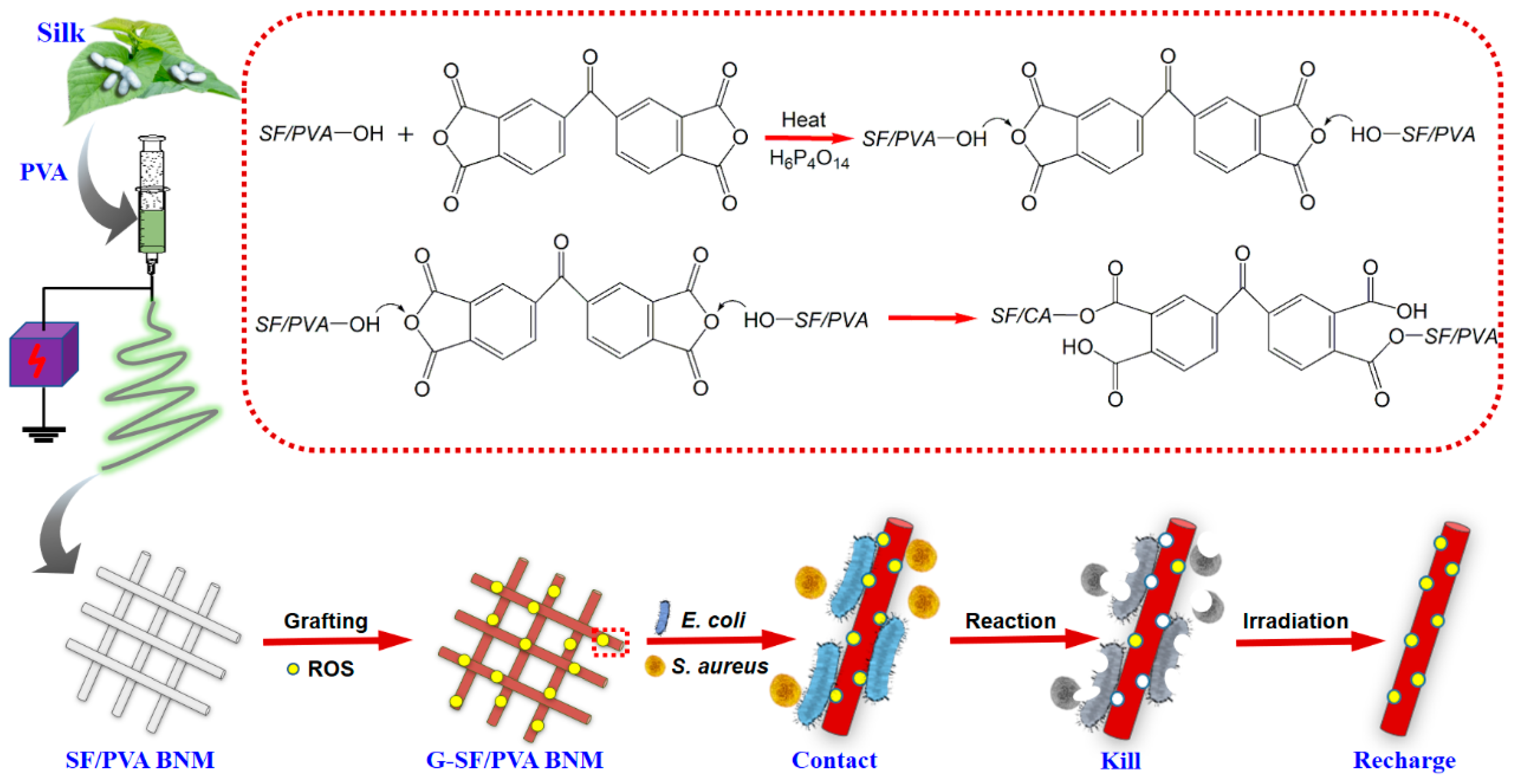
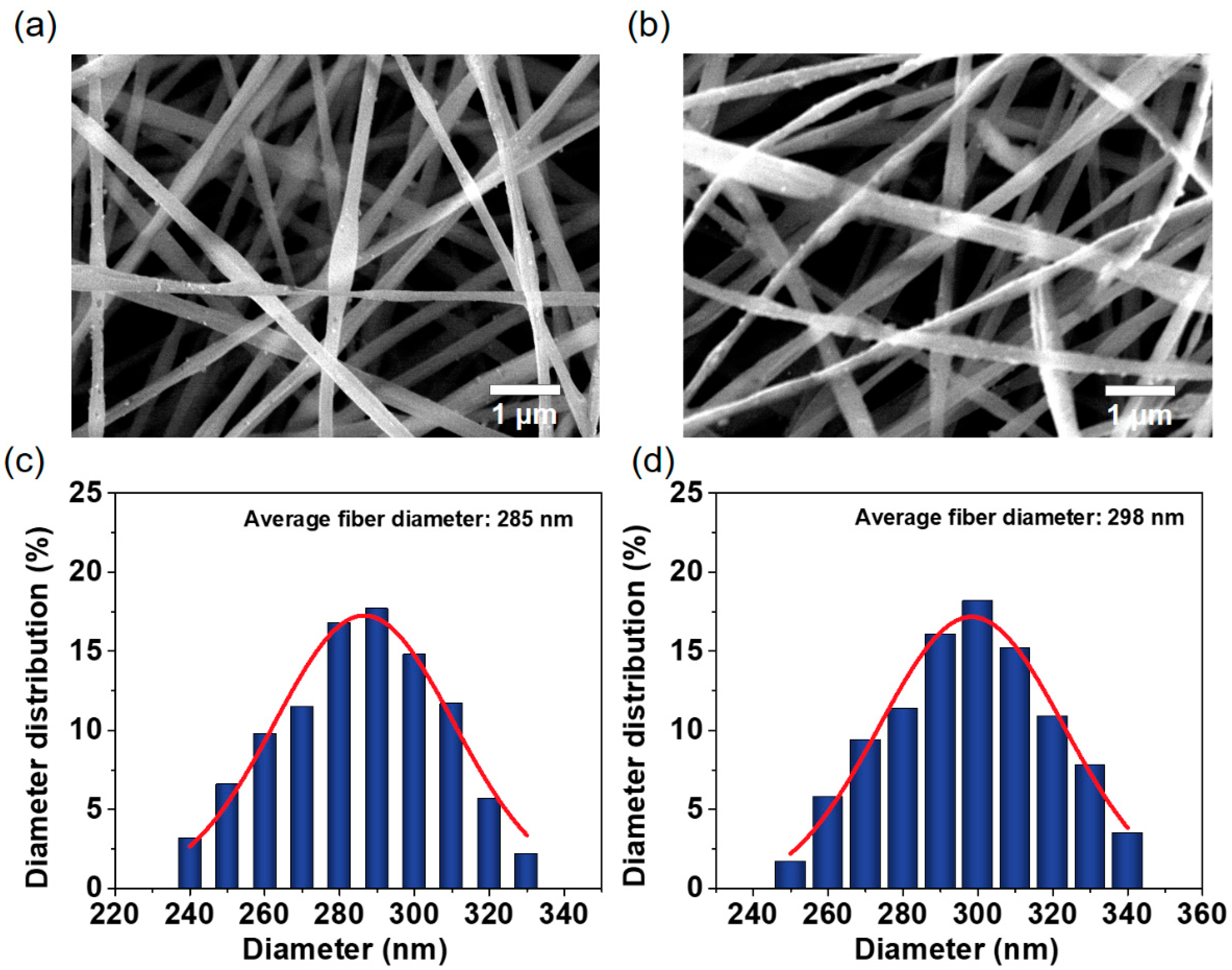

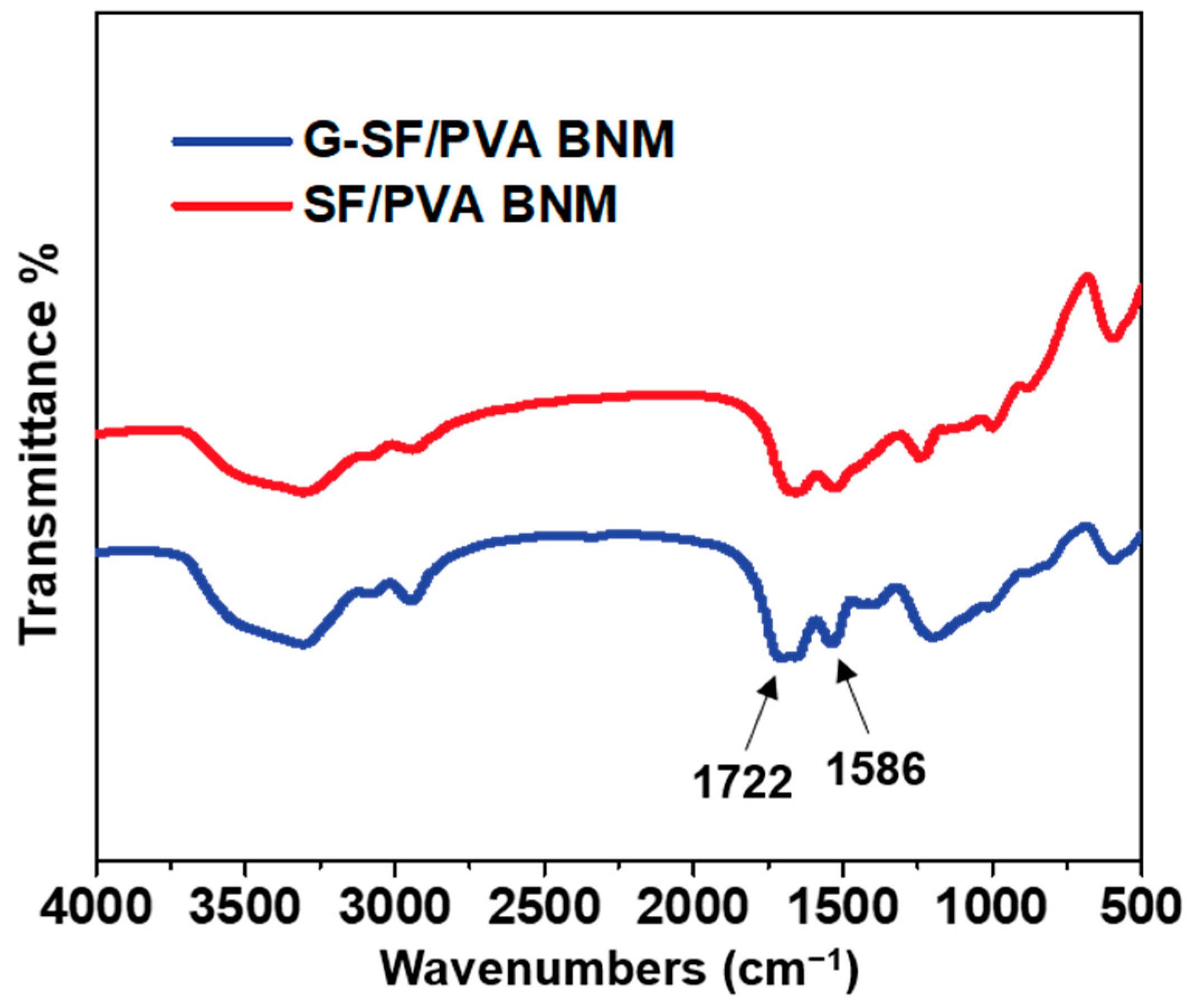
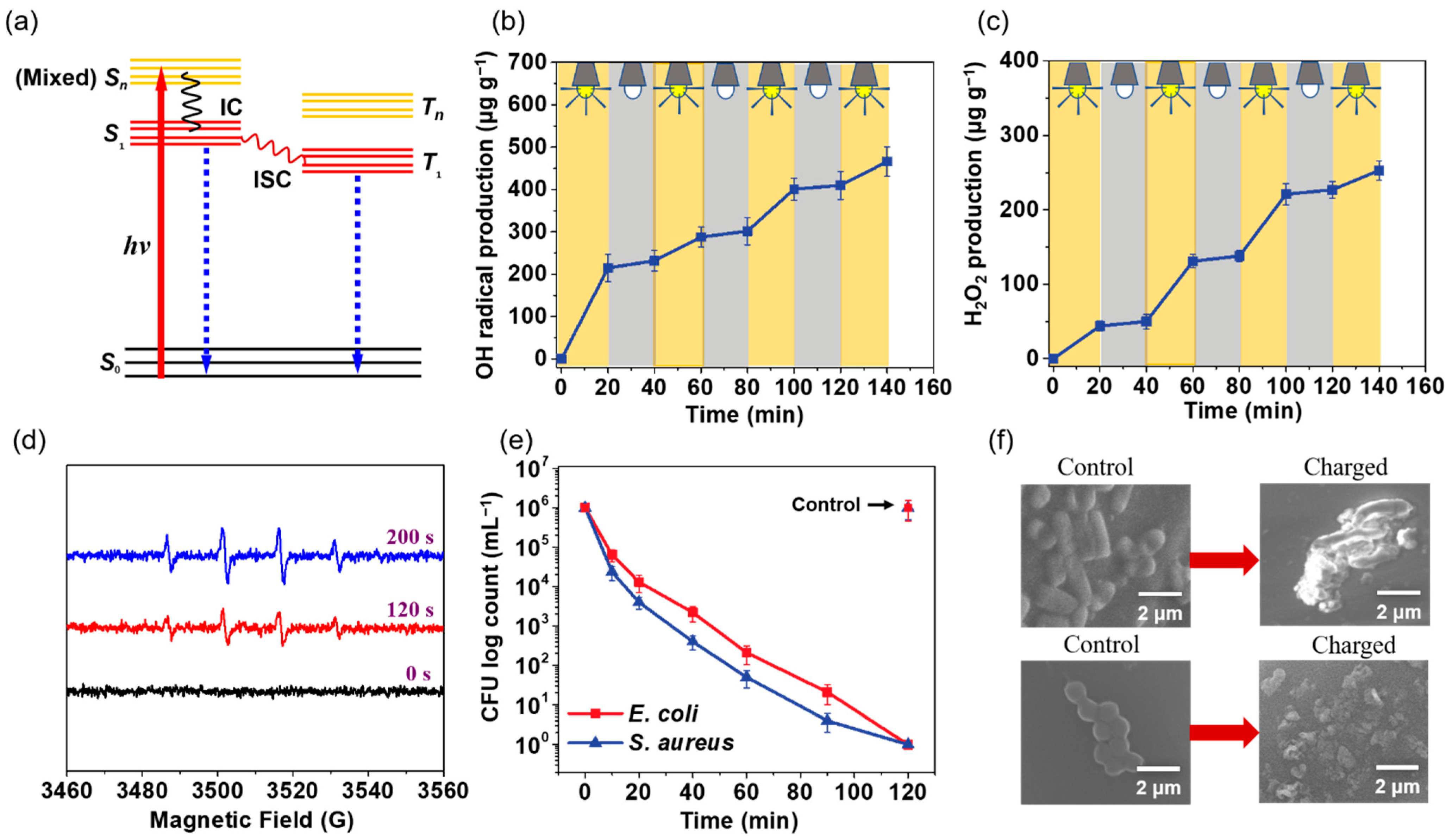
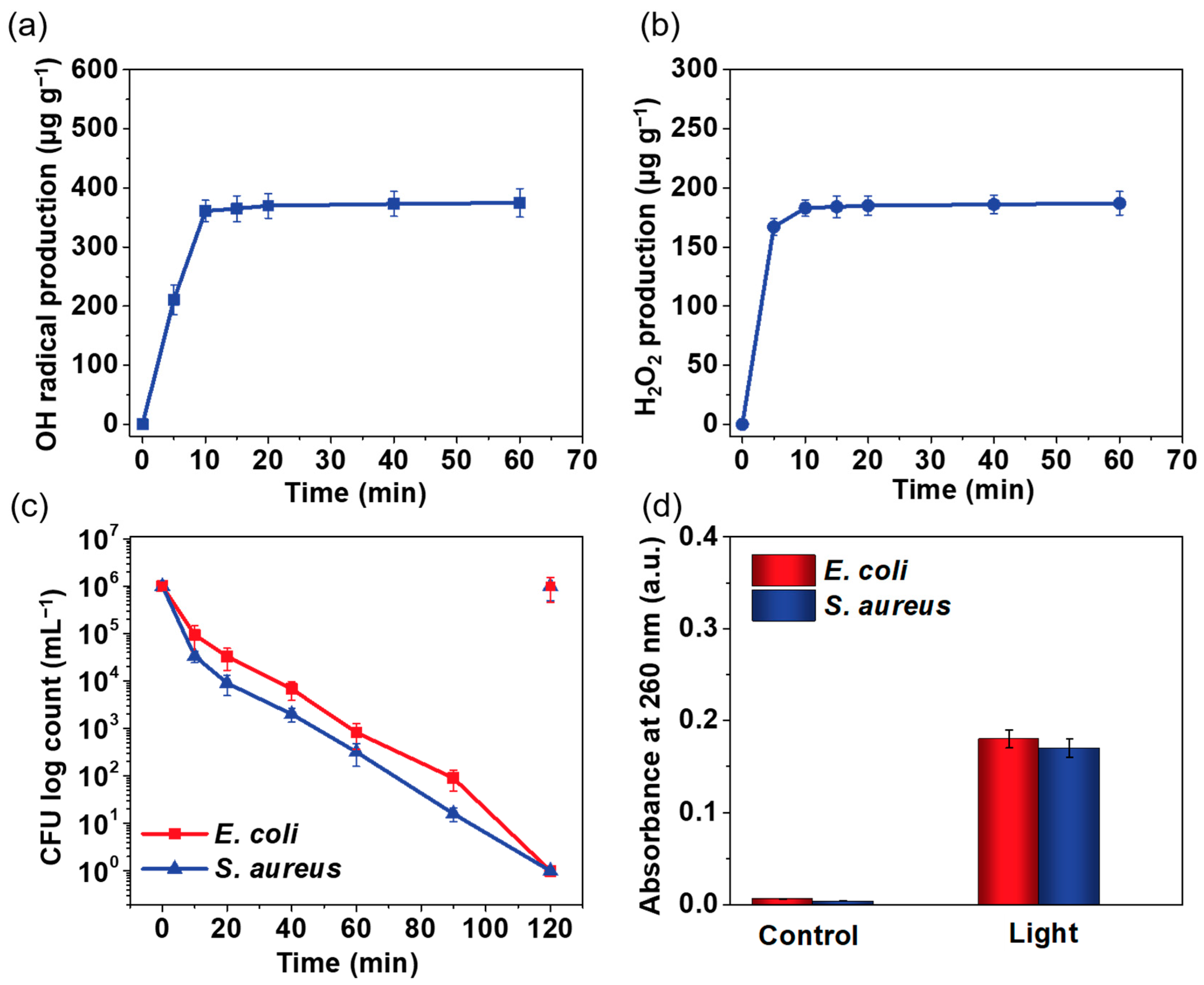
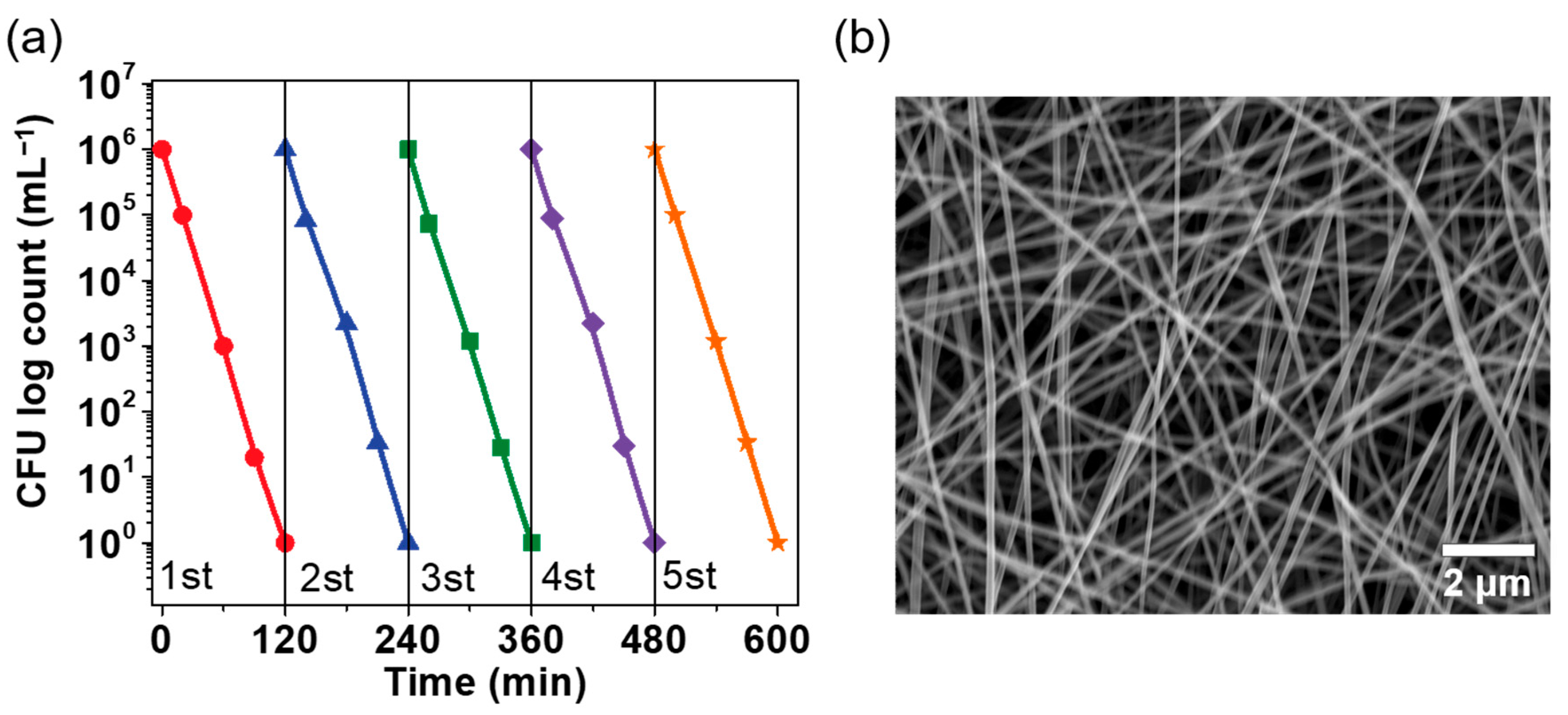
Publisher’s Note: MDPI stays neutral with regard to jurisdictional claims in published maps and institutional affiliations. |
© 2022 by the authors. Licensee MDPI, Basel, Switzerland. This article is an open access article distributed under the terms and conditions of the Creative Commons Attribution (CC BY) license (https://creativecommons.org/licenses/by/4.0/).
Share and Cite
Yi, S.; Wu, J.; Zhou, Y.; Wang, X.; Pu, Y.; Ran, B. Fabrication of Rechargeable Photoactive Silk Fibroin/Polyvinyl Alcohol Blend Nanofibrous Membranes for Killing Bacteria. Polymers 2022, 14, 2499. https://doi.org/10.3390/polym14122499
Yi S, Wu J, Zhou Y, Wang X, Pu Y, Ran B. Fabrication of Rechargeable Photoactive Silk Fibroin/Polyvinyl Alcohol Blend Nanofibrous Membranes for Killing Bacteria. Polymers. 2022; 14(12):2499. https://doi.org/10.3390/polym14122499
Chicago/Turabian StyleYi, Shixiong, Jiaxue Wu, Ying Zhou, Xiaomeng Wang, Yunfei Pu, and Boli Ran. 2022. "Fabrication of Rechargeable Photoactive Silk Fibroin/Polyvinyl Alcohol Blend Nanofibrous Membranes for Killing Bacteria" Polymers 14, no. 12: 2499. https://doi.org/10.3390/polym14122499
APA StyleYi, S., Wu, J., Zhou, Y., Wang, X., Pu, Y., & Ran, B. (2022). Fabrication of Rechargeable Photoactive Silk Fibroin/Polyvinyl Alcohol Blend Nanofibrous Membranes for Killing Bacteria. Polymers, 14(12), 2499. https://doi.org/10.3390/polym14122499





